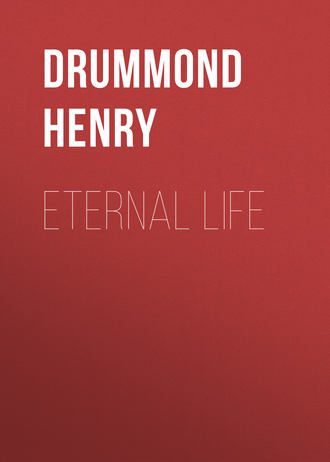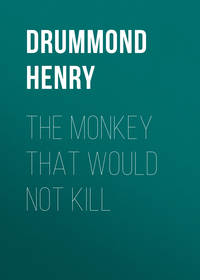 полная версия
полная версияEternal Life
Much more, then, shall we look for the influence of Environment on the spiritual nature of him who has opened correspondence with God. Reaching out his eager and quickened faculties to the spiritual world around him, shall he not become spiritual? In vital contact with Holiness, shall he not become holy? Breathing now an atmosphere of ineffable Purity, shall he miss becoming pure? Walking with God from day to day, shall he fail to be taught of God?
Growth in grace is sometimes described as a strange, mystical, and unintelligible process. It is mystical, but neither strange nor unintelligible. It proceeds according to Natural Law, and the leading factor in sanctification is Influence of Environment. The possibility of it depends upon the mobility of the organism; the result, on the extent and frequency of certain correspondences. These facts insensibly lead on to further suggestion. Is it not possible that these biological truths may carry with them the clue to a still profounder philosophy – even that of Regeneration?
Evolutionists tell us that by the influence of environment certain aquatic animals have become adapted to a terrestrial mode of life. Breathing normally by gills, as the result and reward of a continued effort carried on from generation to generation to inspire the air of heaven direct, they have slowly acquired the lung-function. In the young organism, true to the ancestral type, the gill still persists – as in the tadpole of the common frog. But as maturity approaches, the true lung appears; the gill gradually transfers its task to the higher organ. It then becomes atrophied and disappears, and finally respiration in the adult is conducted by lungs alone.13 We may be far, in the meantime, from saying that this is proved. It is for those who accept it to deny the justice of the spiritual analogy. Is religion to them unscientific in its doctrine of Regeneration? Will the evolutionist who admits the regeneration of the frog under the modifying influence of a continued correspondence with a new environment, care to question the possibility of the soul acquiring such a faculty as that of Prayer, the marvellous breathing-function of the new creature, when in contact with the atmosphere of a besetting God? Is the change from the earthly to the heavenly more mysterious than the change from the aquatic to the terrestrial mode of life? Is Evolution to stop with the organic? If it be objected that it has taken ages to perfect the function in the batrachian, the reply is, that it will take ages to perfect the function in the Christian. For every thousand years the natural evolution will allow for the development of its organism, the Higher Biology will grant its product millions. We have indeed spoken of the spiritual correspondence as already perfect – but it is perfect only as the bud is perfect. "It doth not yet appear what it shall be," any more than it appeared a million years ago what the evolving batrachian would be.
But to return. We have been dealing with the scientific aspects of communion with God. Insensibly, from quantity we have been led to speak of quality. And enough has now been advanced to indicate generally the nature of that correspondence with which is necessarily associated Eternal Life. There remain but one or two details to which we must lastly, and very briefly, address ourselves.
The quality of everlastingness belongs, as we have seen, to a single correspondence, or rather to a single set of correspondences. But it is apparent that before this correspondence can take full and final effect a further process is necessary. By some means it must be separated from all the other correspondences of the organism which do not share its peculiar quality. In this life it is restrained by these other correspondences. They may contribute to it, or hinder it; but they are essentially of a different order. They belong not to Eternity but to Time, and to this present world; and, unless some provision is made for dealing with them, they will detain the aspiring organism in this present world till Time is ended. Of course, in a sense, all that belongs to Time belongs also to Eternity; but these lower correspondences are in their nature unfitted for an Eternal Life. Even if they were perfect in their relation to their Environment, they would still not be Eternal. However opposed, apparently, to the scientific definition of Eternal Life, it is yet true that perfect correspondence with Environment is not Eternal Life. A very important word in the complete definition is, in this sentence, omitted. On that word it has not been necessary hitherto, and for obvious reasons, to place any emphasis, but when we come to deal with false pretenders to Immortality we must return to it. Were the definition complete as it stands, it might, with the permission of the psycho-physiologist, guarantee the Immortality of every living thing. In the dog, for instance, the material framework giving way at death might leave the released canine spirit still free to inhabit the old Environment. And so with every creature which had ever established a conscious relation with surrounding things. Now the difficulty in framing a theory of Eternal Life has been to construct one which will exclude the brute creation, drawing the line rigidly at man, or at least somewhere within the human race. Not that we need object to the Immortality of the dog, or of the whole inferior creation. Nor that we need refuse a place to any intelligible speculation which would people the earth to-day with the invisible forms of all things that have ever lived. Only we still insist that this is not Eternal Life. And why? Because their Environment is not Eternal. Their correspondence, however firmly established, is established with that which shall pass away. An Eternal Life demands an Eternal Environment.
The demand for a perfect Environment as well as for a perfect correspondence is less clear in Mr. Herbert Spencer's definition than it might be. But it is an essential factor. An organism might remain true to its Environment, but what if the Environment played it false? If the organism possessed the power to change, it could adapt itself to successive changes in the Environment. And if this were guaranteed we should also have the conditions for Eternal Life fulfilled. But what if the Environment passed away altogether? What if the earth swept suddenly into the sun? This is a change of Environment against which there could be no precaution and for which there could be as little provision. With a changing Environment even, there must always remain the dread and possibility of a falling out of correspondence. At the best, Life would be uncertain. But with a changeless Environment – such as that possessed by the spiritual organism – the perpetuity of the correspondence, so far as the external relation is concerned, is guaranteed. This quality of permanence in the Environment distinguishes the religious relation from every other. Why should not the musician's life be an Eternal Life? Because, for one thing, the musical world, the Environment with which he corresponds, is not eternal. Even if his correspondence in itself could last eternally, the environing material things with which he corresponds must pass away. His soul might last forever – but not his violin. So the man of the world might last forever – but not the world. His Environment is not eternal; nor are even his correspondences – the world passeth away and the lust thereof.
We find, then, that man, or the spiritual man, is equipped with two sets of correspondences. One set possesses the quality of everlastingness, the other is temporal. But unless these are separated by some means the temporal will continue to impair and hinder the eternal. The final preparation, therefore, for the inheriting of Eternal Life must consist in the abandonment of the non-eternal elements. These must be unloosed and dissociated from the higher elements. And this is effected by a closing catastrophe – Death.
Death ensues because certain relations in the organism are not adjusted to certain relations in the Environment. There will come a time in each history when the imperfect correspondences of the organism will betray themselves by a failure to compass some necessary adjustment. This is why Death is associated with Imperfection. Death is the necessary result of Imperfection, and the necessary end of it. Imperfect correspondence gives imperfect and uncertain Life. "Perfect correspondence," on the other hand, according to Mr. Herbert Spencer, would be "perfect Life." To abolish Death, therefore, all that would be necessary would be to abolish Imperfection. But it is the claim of Christianity that it can abolish Death. And it is significant to notice that it does so by meeting this very demand of Science – it abolishes Imperfection.
The part of the organism which begins to get out of correspondence with the Organic Environment is the only part which is in vital correspondence with it. Though a fatal disadvantage to the natural man to be thrown out of correspondence with this Environment, it is of inestimable importance to the spiritual man. For so long as it is maintained the way is barred for a further Evolution. And hence the condition necessary for the further Evolution is that the spiritual be released from the natural. That is to say, the condition of the further Evolution is Death. Mora janua Vitæ, therefore, becomes a scientific formula. Death, being the final sifting of all the correspondences, is the indispensable factor of the higher Life. In the language of Science, not less than of Scripture, "To die is gain."
The sifting of the correspondences is done by Nature. This is its last and greatest contribution to mankind. Over the mouth of the grave the perfect and the imperfect submit to their final separation. Each goes to its own – earth to earth, ashes to ashes, dust to dust, Spirit to Spirit. The dust shall return to the earth as it was; and the Spirit shall return unto God who gave it"
1
"Principles of Biology," p. 82.
2
"Principles of Biology," p. 88.
3
John xvii.
4
Vide Sir John Lubbock's "Ants, Bees, and Wasps," pp. 1, 181.
5
Büchner: "Force and Matter," 3d ed., p. 232.
6
"The Creed of Science," p. 169.
7
"Force and Matter," p. 231.
8
1 Cor. ii. 11, 12.
9
Rom. viii. 35-39.
10
Vide "Conformity to Type," page 287.
11
"History of Christian Theology in the Apostolic Age," vol. ii. p. 496.
12
1 John v. 20.
13
Vide also the remarkable experiments of Fräulein v. Chauvin on the Transformation of the Mexican Axoloti into Amblystoma. – Weismann's "Studies in the Theory of Descent," vol. ii. pt. iii.




